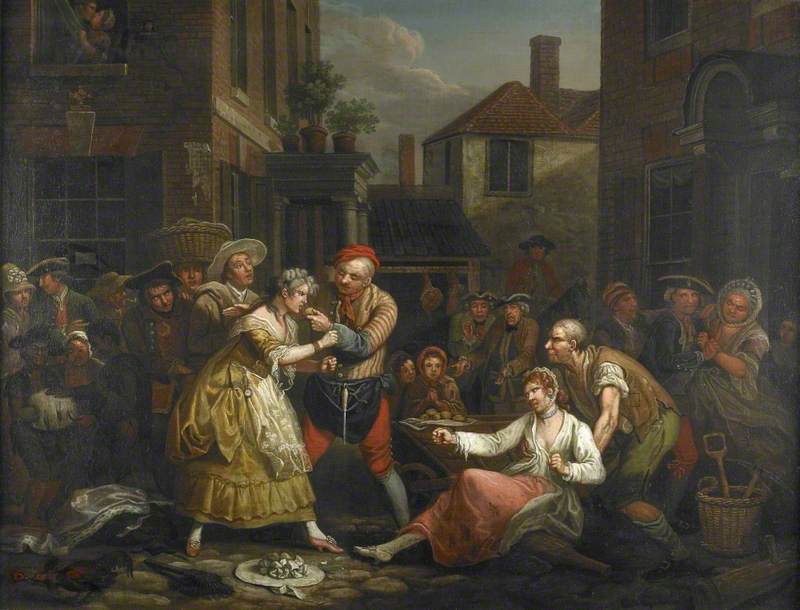The first rule of Fight Club is: you do not talk about Fight Club.
The second rule of Fight Club is: you DO NOT talk about Fight Club!
- Chuck Palahniuk, Fight Club
Could it be a case of authorial oversight that all subsequent rules are exclusively concerned with such practical matters as dress and fight duration?
Given the macho reputation of both the book and the film adaptation, it seems like the third rule of Fight Club should be: you DO NOT talk about the fact that a fair number of Edwardian ladies were badass bare knuckle fighters.
Because doing so might diminish Fight Club’s street cred just a bitsy…
Filmmaker (and popular audiobook narrator) Emily Janice Card has a good deal of fun in Jane Austen’s Fight Club, above, marrying Palahniuk’s tropes to the social mores of England’s Regency period.
“No corsets, no hat pins and no crying,” Tyler Durden stand-in Lizzie instructs the eager young ladies in her circle. Soon, they’re proudly sporting bruises beneath their bonnets and stray blood spots on their tea dresses.
While young women of the fictional Bennet sisters’ social class refrained from brutal fisticuffs, there’s ample evidence of female combatants from the proletarian ranks. They fought for money, and occasionally to settle a disagreement, training hard for weeks in advance.
Their bouts drew spectators to the amphitheater owned by boxing promoter James Figg, and the marvelously named Hockley in the Hole, a seedy establishment whose other attractions included bearbaiting, bullbaiting, and fighting with broadswords and cudgels.
The female fist fighters challenged each other with paid notices in local papers, like this one from “championess and ass-driver” Ann Field of Stoke Newington:
Whereas I, Ann Field, of Stoke Newington, ass-driver, well known for my abilities, in boxing in my own defense wherever it happened in my way, having been affronted by Mrs. Stokes, styled the European Championess, do fairly invite her to a trial of her best skill in Boxing for 10 pounds, fair rise and fall; and question not but to give her such proofs of my judgment that shall oblige her to acknowledge me Championess of the Stage, to the satisfaction of all my friends.
Mrs. Stokes promptly announced her readiness to come out of retirement:
I, Elizabeth Stokes, of the City of London, have not fought in this way since I fought the famous boxing- woman of Billingsgate 29 minutes, and gained a complete victory (which is six years ago); but as the famous Stoke Newington ass-woman dares me to fight her for the 10 pounds, I do assure her I will not fail meeting her for the said sum, and doubt not that the blows which I shall present her with will be more difficult for her to digest than any she ever gave her asses.
Rather than keeping mum on Fight Club, these female pugilists shared Muhammad Ali’s flare for drumming up interest with irresistibly cocky wordplay.
References to adversaries fighting in “close jacket, short petticoats, and holland drawers … with white stockings and pumps” suggest that the adversaries played to the spectators’ prurience, though not always. Unlike the 20th-century stunt of bikini clad jello wrestling, sex appeal was not obligatory.
In a chapter devoted to public entertainments, sports and amusements, Alexander Andrews, author of The Eighteenth Century or Illustrations of the Manners and Customs of Our Grandfathers, documents how the Merry Wives of Windsor, a crew comprised of “six old women belonging to Windsor town” took out an ad seeking “any six old women in the universe to outscold them.”
On June 22nd, 1768, a woman called Bruising Peg “beat her antagonist in a terrible manner” to win a new chemise, valued at half a guinea.
In 1722, Hannah Hyfield of Newgate Market, resolved to give her challenger, Elizabeth Wilkinson, “more blows than words,” promising to deliver “a good thumping.” Both parties agreed to hold a half-crown in their fists for the duration of the fight. William B. Boulton, author of 1901’s Amusements of Old London, speculates that this was a practical measure to minimize scratching and hair-pulling.

Time travel to an 18th-century female bare knuckles fight via Female Single Combat Club’s exhaustive coverage, Sarah Murden’s excellent analysis of John Collet’s painting, The Female Bruisers, above, or Jeremy Freeston’s short documentary available on YouTube.
Related Content:
Watch Author Chuck Palahniuk Read Fight Club 4 Kids
Ayun Halliday is an author, illustrator, theater maker and Chief Primatologist of the East Village Inky zine. Follow her @AyunHalliday.


Leave a Reply